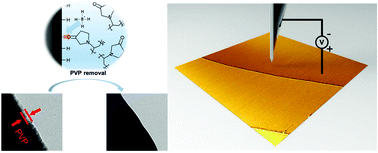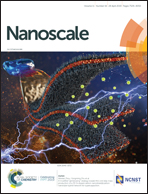Ultra-sharp and surfactant-free silver nanowire for scanning tunneling microscopy and tip-enhanced Raman spectroscopy†
Abstract
Chemically-synthesized single-crystalline silver nanowire (AgNW) probes can combine the scanning tunneling microscopy (STM) technique with tip-enhanced Raman scattering spectroscopy (TERS) for complementary morphological and chemical information with nanoscale spatial resolution. However, its performance has been limited by the blunt nanowire tip geometry, the insulating surfactant layer coating AgNW surfaces, and the thermal-induced mechanical vibrations. Here, we report a reproducible fabrication method for the preparation of sharp-tip AgNW-based TERS probes. By removing the polyvinylpyrrolidone (PVP) surfactant molecules from the AgNW surfaces for stable electrical conductivity and controlling the protruding length with μm-level accuracy for improved mechanical stability, we demonstrate atomic-resolution STM imaging with the sharp-tip AgNW probe. Furthermore, the sharp-tip AgNW has an excellent TER enhancement (∼1.1 × 106), which is about 66 folds of that achieved by regular AgNWs. Our experiments demonstrate that AgNWs with clean interfaces and the proper tip geometry can provide reliable and reproducible STM and TER characterizations, which remove the hurdles preventing the implementation of AgNW in STM-based near-field optical applications for a broad community.



 Please wait while we load your content...
Please wait while we load your content...